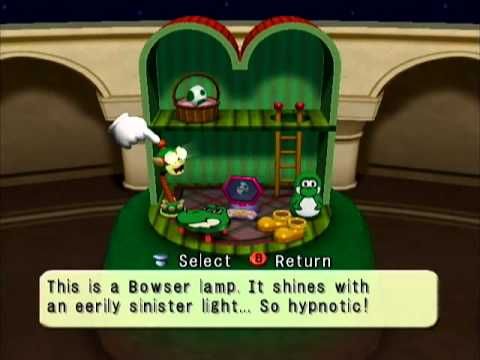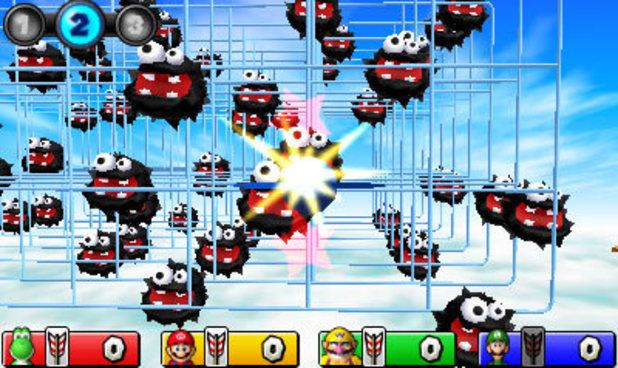
Mario Party Island Tour Review
Welcome to the expansive world of Mario Party where the rules are real complex and your friends don’t matter. That is, they won’t want anything to do with you after you whoop their butt in a serious session of Skateboard Scamper. With previous installments taking place on big name Nintendo Consoles, Mario Party Island Tour was a seemingly refreshing break from the average “plop-yourself-in-front-of-a-large-screen-and-play-for-hours” style of gaming. And not only does Mario Party Island Tour allow for more touch-and-go when you’re on the go action, but the masterminds at ND Cube and Nintendo have implemented a refreshing take on everybody’s favorite virtual board game. This ain’t no Bowser space. Hang tight as we boost into a Rare Gamer Review of Mario Party Island Tour.

It doesn’t matter how you roll the dice. Mario Party is hands down one of Nintendo’s better party game franchises. However, as with every franchise, there come some games that just outright need improvement. Now I’m not saying that Mario Party Island Tour is a bad game, but there are certain elements that should cater to the player more than they do. First off, Mario Party Island Tour is a very short game. There are a total of seven boards that even go so far as to implement an estimated time stamp of how long it should take you to complete each one. And one of them you can’t even play without having friends connect to your DS to play with you. I have yet to even experience Shy Guy Shuffle City because, well, I don’t have any friends… Er… That is, friends who own the game… Anyways, the largest board in the game can have a session wrap up in less than an hour. I’m used to Mario Party 4 and 5 where beating minigames to gain collectables was a huge deal. To this day, I still haven’t completed all the requirements to fill the present room in Mario Party 4. Needless to say, when I beat Island Tour in only few hours, I was mildly disappointed. Especially considering that the only in game collectables unlock sections of the in game sound test. Bravo, Nintendo. Bravo.
The infamous Mario Party 4 Present Room holds more slaves to the fleeting idea of 100% completion than those attempting to finish Donkey Kong 64.
Second, one of the newer additions to the Mario Party franchise isn’t so much as an addition, but rather a change altogether. Instead of traditional Monopoly style game play where the characters go around the board trying to gain stars, buy items, rack up coins and land on wacky spaces, Island Tour starts fresh with a new design to the board game mechanic: A Race to the Finish. That’s right. Mario Party has successfully ripped the reward stars out of the equation and has based the player’s experience on strategy and chance. But wait, there’s more! Also included are obstacles in the game as a means of hindering a player from proceeding. That feature, however, is more of a success than a failure in my mind. Fearing that a Bullet Bill may strike you on an off turn and send you hurdling back to the start really pumps your adrenaline. And when he does strike, well let’s just say that the dice won’t be the only thing flying that round.
In Island Tour, many of your decisions on the board are dependent on how you roll the dice. Rolling a six as opposed to rolling a one could determine how far you travel next turn if you land on a boost space in Rocket Road or whether you win or lose if you need the exact number of spaces to complete Kamek’s Carpet Ride. And did I mention you have the option to roll a zero? Since when has that ever been a thing? That being said, in a game that’s turn based, lady luck is on the side of the player who goes first. While this isn’t always the case, it’s been the case more times than I can count in the amount of times I’ve picked up my 3DS. The positive end of this feature allows us the first pick of a set of rewards if we win the minigame for that round. Cards with number spaces or boosts to add numbers to your dice block can really come in handy if you’re a master of the art of miniature gaming.
It’s basically Super Mario Galaxy, but with Style.
One of the biggest new features added into the series is the idea of luck. The player now when facing against the computer has a chance to lose even on the easiest of settings! And while this feature has likely been used before, the extent to which it’s exploited has, to my knowledge, never gone this far. For example, in the minigame Helter Shellter, the player has to pick the shell with the most pearls hidden inside. The difficult part? There are no indicators to help the player pick which shell may contain more pearls than its counterparts. Everything is all left up to chance. While this isn’t a huge deal, it has a tendency to be frustrating when the outcome of these minigames directly affects how your character plays on the board. If the player loses a minigame to chance and suddenly forfeits a good reward, it may be the difference between life and death in a race to the finish situation.
At least they’re filled with pearls and not coal. Sometimes you even get seaweed!
Now I’ve already drawn on quite a few negatives within this game, but one of the positive features implemented is the large amount minigames relative to the size of the cartridge. Coming in at a whopping 69 minigames, there’s enough going on to where you don’t feel pressured into playing the same game every few turns. On top of that, there are special boss battle minigames that you can unlock by playing through a special minigame battle based adventure called Bowser’s Tower. Within the tower, you clash head to head in a minigame battle with three translucent copies of the one of the 8 choices on the character select screen. Your reward for enduring all thirty floors of Bowser’s Tower? Unlocking the final playable character. Then you can come back and do it all again for the ever so amazing reward of nothing!
Back on the subject of minigames, the hard workers at NDcube and Nintendo made sure to try to make them the right way. As if it wasn’t obvious, tilting the DS has become a popular feature in many recent games. The feature was well represented in Mario Party Island Tour and can be a tad pesky at times. However, in order to prevent any unwanted aiming errors, a feature to “center” your 3DS was implemented by simply tapping the down arrow on the D-Pad. This allows you to continue the difficult aiming process from a view that you want. Not a view determined by the slightest move of your wrist.
Aren’t those the little fuzzy things that… *gulp* suck your blood?
At the end of the day, one can truly appreciate Mario Party Island Tour for the attempt. The opening select screen has the player viewing the island as a whole. It’s very reminiscent of the first Mario Party’s area select screen. The music is phenomenally done as this Jumanji situation successfully sucks the player into the game. The boards themselves are actually quite fun to play if your luck doesn’t wear so thin, and the replay value is pretty good. This installment attempts to operate as a Mario Party you can play without your friends, and while it does succeed, it gets hard to pick up the game again after the first play through and a half. The vibrant colors, the escape from reality and old world Mario Party tactics whisks the player away to a new experience presented in Mario Party Island Tour. This game is definitely worth a rent, but you’ll have to think twice about purchasing to own. Banzai Bill can take this one away as he blasts Mario Party Island Tour into a score of two out of five.
2/5
Categories: Reviews




0 Comments
This post has been left all alone with no comments. Don't leave it lonesome - give it some company with a comment.